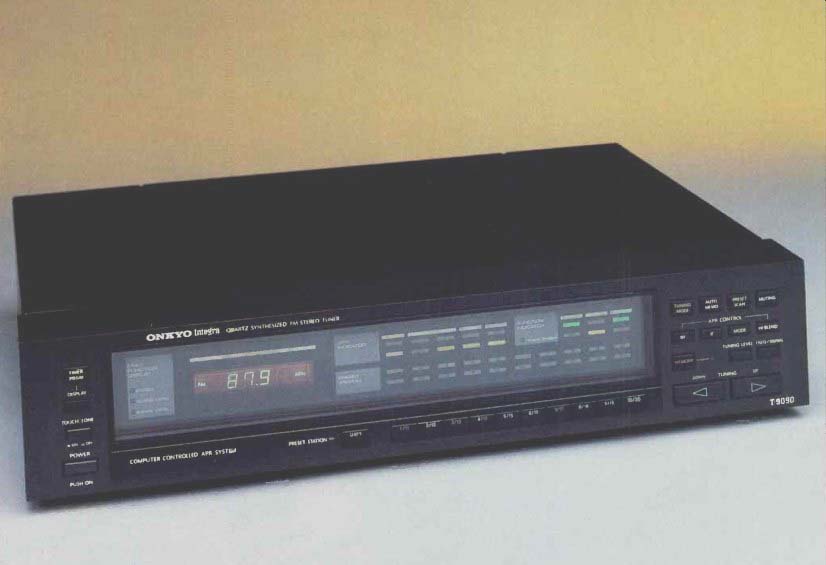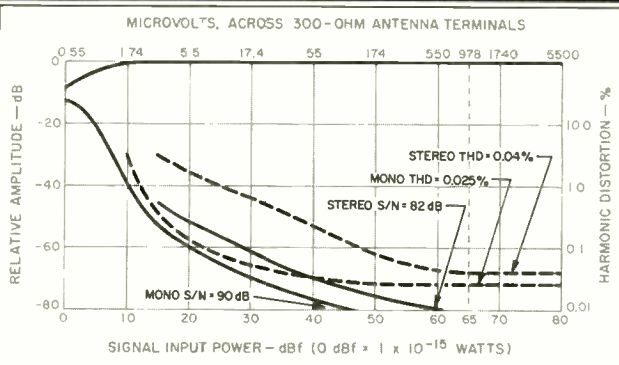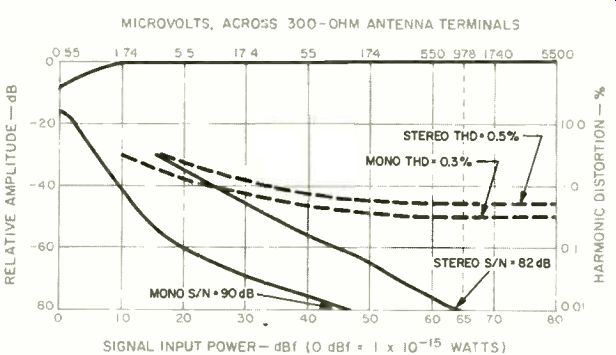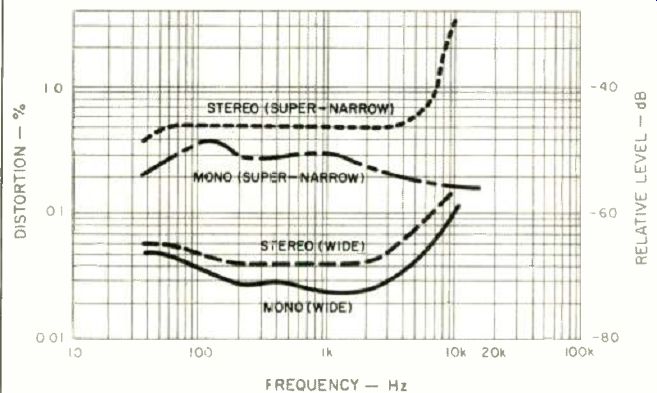
Manufacturer's Specifications
Usable Sensitivity: Mono, 12.8 dBf; stereo, 17.2 dBf.
50-dB Quieting Sensitivity: Mono, 15.8 dBf; stereo, 37.2 dBf.
S/N: Mono, 95 dBf; stereo, 85 dBf.
THD: Mono, 0.009% (wide i.f.); stereo, 0.02% (wide i.f.).
Frequency Response: 30 Hz to 15 kHz, +0.5,-1.0 dB.
Capture Ratio: 1.0 dB.
AM Suppression: 60 dB.
I.f. Rejection: 100 dB.
Image Rejection: 100 dB.
Selectivity: 80 dB (super-narrow Separation: 55 dB at 1 kHz (wide i.f.); 33 dB, 70 Hz to 10 kHz.
Output Level: 0 to 1.5 V.
Antenna Input Impedance: 75 ohms, unbalanced.
Dimensions: 17 3/4 in. (45.1 cm) W x 4 in. (9.9 cm) H x 15 3/8 in. (38.8 cm) D.
Weight: 14.5 lbs. (6.6 kg).
Price: $599.95.
Company Address: 200 Williams Dr., Ramsey, N.J. 07446.
For a tuner manufacturer to affix a $600 price tag to an FM tuner these days, that manufacturer had better have some thing out of the ordinary by way of a product. FM tuner technology has advanced very rapidly in recent years, and along with ever more sophisticated and effective circuitry have come lower costs, thanks to the increased use of multi function, large-scale integrated circuits. Let me state right at the outset of this review that Onkyo's suggested price for their T-9090 tuner is fully justified-and then some. The T 9090 is the kind of tuner that many FM listeners would have gladly paid twice as much for just a few years ago--if it had been available at the time. Think of this tuner as a reception problem-solver.
The tuner's most outstanding feature is its ability to set up operating modes and thus extract the best possible signal available under a wide variety of circumstances As usual, Onkyo has come up with an acronym for this feature: APR. (Only when I got to the last page of the brief operating manual did I learn that these initials stand for Automatic Precision Reception.) APR is a system that automatically sets the r.f. stage gain (local or distant), i.f. bandwidth (wide, narrow, or super-narrow for extremely high selectivity), stereo/mono mode, and high-blend. Settings are based upon the quality of the incoming signal, including such parameters as field strength, distortion and noise.
Normally, I would object to having a tuner make all these decisions for me (sometimes I want to hear just how noisy a weak-signal stereo station sounds in my location), but not in the case of this one. That's because Onkyo wisely provided a means for overriding the APR system-just for FM masochists like me!
Control Layout
At first glance, the front panel of the T-9090 seemed very "busy," with its profusion of buttons and alphanumeric displays. Upon closer examination, however, I realized that each item on the crowded front panel served a useful purpose, and that the control buttons were quite logically arranged after all. At the extreme left of the panel are a power on/off button, two buttons associated with timer turn-on (an external timer would be required), and a toggle button that turns a built-in "beep" tone on and off. This tone, if left on, will beep every time almost anything on the tuner is changed or activated. The owner's manual suggests: "Use this switch to turn off the tone when not needed," and that's just what I did as soon as I was satisfied that it worked as advertised! The main numeric display is multi-functional. It shows the tuned frequency, signal strength (actually calibrated in dBf), muting- or tuning-level setting (there are three muting levels possible: 17, 27, and 37 dBf), and the number of the preset station currently being listened to. Normally, this display shows tuned-to frequency; the other displays are activated when appropriate pushbuttons are touched. They then appear for 2 S, after which the display returns to the frequency-indicating mode.
To the right of this major display area are indicators which tell you the status of the various operating modes selected manually or by the special APR circuitry. Below these are 20 numbered indicators to tell you which of the 20 preset stations has been selected and is being received. The function keys that both assign and select the preset stations are arranged to operate much like keys of a typewriter.
There are only 10 of them, but they can select 20 different preset frequencies using an additional shift key (button number 1 becomes 11, 2 becomes 12, etc.). At the upper right of the panel are touch buttons which can be used to override the APR decisions, as well as buttons for selecting "Tuning Mode" (automatic or manual), a button which sets in motion the preset scanning function (the tuner moves sequentially to all of your preset stations, letting you listen to each for about 5 S), a key for entering preferred stations into he preset memory circuitry, the muting-level key for setting any of the three available muting thresholds, and a key for switching the frequency display over to its signal-strength display function. "Up" and "Down" tuning keys are at the lower right corner of the front panel.
The rear panel of the T-9090 is equipped with only a 75-ohm, coaxial, antenna transmission-line connector. How ever, Onkyo supplies a small, accessory, 300 to 75-ohm transformer for those who wish to use 300-ohm transmission lines from their antennas to this tuner. Fixed and variable output jacks as welt as horizontal and vertical oscilloscope jacks are located near the center of the rear panel (the 'scope jacks are for observation of multipath problems). An output-level control nearby completes the simple rear-panel layout of the T-9090.
Measurements
Most of the measurements I made in the lab had to be done twice, once in the wide-band i.f. mode and then again in the super-narrow mode. I made a few measurements using the intermediate, narrow mode but discovered that distortion and separation figures fell just about midway between those obtained for the two extreme settings.

Fig. 1--Mono and stereo quieting and distortion characteristics, FM section,
in wide-band i.f. mode.

Fig. 2--Mono and stereo quieting and distortion characteristics, FM section,
in super-narrow i.f. mode.

Fig. 3--Harmonic distortion vs. frequency, n super-narrow and wide i.f. modes.

Fig. 4--Frequency response and separation vs. frequency, in wide (A), narrow
(B), and super-narrow (C) i.f. modes. Top two traces in each photo show
response first without and then with blend; the bottom pair of traces show
separation first with and then without blend.
Figure 1 shows how quieting and harmonic distortion (for a 1-kHz modulating signal) vary with increasing signal strength in the wide-band i.f. mode. Mono usable sensitivity was an impressively low 10 dBf, considerably better than the 12.8 dBf claimed by Onkyo. Even in stereo, usable sensitivity measured only 15 dBf, considerably better than the 17.2 dBf claimed by the manufacturer. In mono, 50-dB quieting was obtained for signal strengths of 12 to 14 dBf (depending upon the i.f. bandwidth setting); for stereo, the signal strength needed to achieve 50 dB of quieting ranged from 19 dBf in the wide i.f. mode to 35 dBf in the super-narrow mode. Figure 2 shows quieting and THD for mono and stereo operation in the super-narrow i.f. mode.
The best signal-to-noise ratio I was able to measure with strong signals was 90 dB for mono and 82 dB for stereo. I won't quibble with Onkyo's claim of 95-dB S/N in mono since, frankly, I don't know for sure whether my test equipment is even capable of measuring signal-to-noise ratios in excess of 90 dB. Suffice it to say that the mono S/N I measured for the T-9090 beats anything I have ever measured for a tuner before.
Test equipment may have been the limiting factor in my measurements of harmonic distortion too. In the wide i.f. mode, I measured a distortion level of only 0.025% for mono and 0.04% for stereo. Admittedly, that's not as low as the 0.009% (mono) and 0.02% (stereo) figures claimed by Onkyo, but when you get down to such low levels of THD, it's hard to say whether the residual distortion is a function of test equipment, minute changes in tuner alignment, or other causes. In any case, these THD levels are obviously not going to be audible. As you might expect, switching to the super-narrow mode for higher selectivity always involves a trade-off against distortion and stereo separation. In the case of the T-9090, THD rose to 0.35% for both mono and stereo operation.
Figure 3 shows how harmonic distortion varies with frequency for both wide and super-narrow i.f. settings in mono and stereo. The three 'scope photos of Fig. 4 show how frequency response and separation vary with different i.f. settings. In each of these photos, the top two traces represent frequency response (from 20 Hz to 20 kHz) of the modulated channel, first without, then with the blend circuit.
The bottom pair of traces in each case shows separation as a function of frequency (the scale is 10 dB per vertical division), with the least separation occurring when the blend circuit is manually activated. Figure 4A was plotted with the tuner set to the wide i.f. mode, in Fig. 4B the narrow mode was used, and in Fig. 4C the super-narrow setting was employed. An unusual, slight attenuation of high frequencies in each upper curve occurred when the high-blend circuit was introduced. In other words, for some reason, when the high-blend circuit is used, not only does separation at high frequencies decrease markedly, but the other wise flat frequency response of the tuner is somewhat altered at the high end. Without the use of the blend circuit, separation in the wide i.f. position measured 57 dB at 1 kHz, 30 dB at 10 kHz, and 44 dB at 100 Hz. In the super-narrow i.f. setting, separation decreased to a still very satisfactory 42 dB at 1 kHz, 28 dB at 10 kHz, and 41 dB at 100 Hz.

Fig. 5--Crosstalk and distortion products in wide (A) and super-narrow (B)
i.f. modes, with a 5-kHz, 100% modulating signal. Sweep is linear from
0 Hz to 50 kHz.
Figures 5A and 5B also dramatically illustrate how i.f. bandwidth affects distortion of a received audio signal. In these 'scope photos, the spectrum analyzer has been used to display a 5-kHz modulating signal as seen from the desired output (the tall spike at the left of each photo), followed by a second, stored sweep which shows the output of the unmodulated channel under the same conditions.
Here the sweeps are linear from 0 Hz to 50 kHz in 5-kHz steps. Notice that in- the wide i.f. position (Fig. 5A) there is very little evidence of crosstalk or distortion components at the output of the unmodulated channel (to the right of the main 5-kHz output spike). By contrast, in the super-narrow position (Fig. 5B), though separation is approximately the same (the shorter spike inside the taller one is about 26 dB lower in amplitude than the 5-kHz signal at the desired channel output), there are now several distortion and cross talk components visible to the right of the 5-kHz signal.
Image and i.f. rejection for this tuner measured more than 100 dB (the limit of my test equipment), while AM suppression was an outstanding 75 dB. Capture ratio measured 1.2 dB, and subcarrier and SCA rejection were both in excess of 71 dB. Alternate-channel selectivity in the narrow position measured approximately 80 dB, increasing to better than 90 dB in the super-narrow i.f. setting.
Use and Listening Tests
I must confess that when it comes to FM, I am always turned on by a top-performing tuner or receiver. The T-9090 is just such a component. It's the kind of tuner that makes you wish there were more really conscientious FM broad casters out there who were willing to devote the time and effort necessary to provide the kind of sound quality that this model can deliver. Fortunately, I have a couple of stations in my area that do care about good sound, and when you tune them in on a tuner such as this one, you realize just how good a sound-and how quiet a background-FM radio can provide. The T-9090's judgment with respect to modes of operation using the APR circuitry were better than my own. The tuner correctly analyzed a variety of incoming signals and made the right decisions about i.f. bandwidth and local/distant modes (or r.f. gain). In the case of a few really noisy stereo FM signals, it even turned on the blend control to reduce high-frequency hiss. Much as I would like to think that I could make better judgments than the built-in circuits, I have to confess that I was never able to honestly disagree with the decisions made automatically by this uncannily clever tuner.
In my listening area, having as many as 20 presets doesn't seem like overkill, though I know that in some areas there aren't even 20 signals available, let alone that many preferred stations. Using my outdoor antenna and a rotator, I was able to pick up 73 usable signals, some 49 of them in acceptably quiet stereo-including those for which the tuner decided to turn on the blend control. I haven't looked back over the last few years worth of tuner reports, but I suspect that this may be a new record. I have always admired Onkyo's r.f. products, and with the T-9090 they have really outdone themselves. Now, if more FM broad casters would take their cue from Onkyo and start catching up, the true promise of high-fidelity FM radio would really be fulfilled.
-Leonard Feldman
(Source: Audio magazine, May 1985)
Also see:
Onkyo Integra T-4700 Tuner (Equip. Profile, Jun. 1990)
Onkyo T-9090II FM Tuner (Equip. Profile, Jul. 1988)
Onkyo Model A-7 Integrated Amplifier (Jan. 1978)
Onkyo DX-G10 Compact Disc Player (Mar. 1989)
Optonica ST-3636 AM/FM Stereo Tuner (Dec. 1978)
= = = =